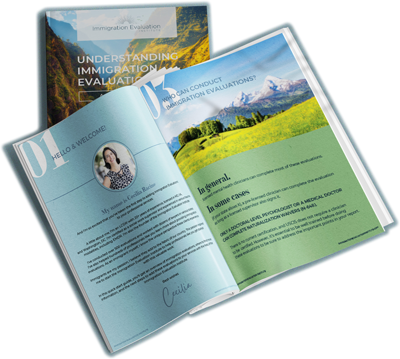What do you want to learn more about?
Post-Traumatic Stress Disorder (PTSD) and Immigrants

New research coming out of George Mason University’s College of Health and Human Services has found that undocumented Latina immigrants met the threshold for a PTSD diagnosis at nearly four times (34%) the rate of civilian women in America (9.7%; Cleaveland & Frankenfeld, 2019).
Although most of the women studied immigrated to the United States to escape struggles in their countries of origin (e.g., violence, poverty), the research found that time in the United States did not lessen trauma symptoms among the women studied.
Causes of PTSD Amongst Immigrant Populations
It’s not a new story. There is an abundance of research indicating that immigrants experience PTSD at a disproportionate rate compared to general populations around the world.
A key criterion associated with the diagnosis of PTSD is exposure to events that threaten death, injury, or sexual violation (American Psychiatric Association, 2013). Research has shown that immigrants are disproportionately at risk of being exposed to these events upon taking up residence in a new country (Bustamante, 2018); they are often faced with unique stressors and traumatizing experiences associated with the acculturation process. These stressors can include (but are not limited to):
- Racial discrimination
- Urban violence
- Abuse by law enforcement officers
- Forced removal or separation from families
- Detention or reclusion
- The threat of deportation
These stressors in the new country often arise as additional to trauma stemming from an immigrant’s experiences in their home country, such as:
- Exposure to hunger, thirst, and lack of shelter
- Injury and illness
- Witnessing or being a victim of violence
- War and conflict
- Persecution based on race, religion, politics, gender, or ethnicity
- Trafficking
- Physical, sexual, or emotional abuse
Therefore, mental illness can arise not only from the conditions that led an immigrant to leave their home country in the first place but from their experiences in the new country. Indeed, the study by Bustamante (2018) found that the prevalence of PTSD among migrants was extremely high (47%), especially among refugees, who were shown to experience it at nearly twice the rate of migrant workers.
PTSD in Immigrant Children
It’s often the case that PTSD comes to light for young children who have been referred to mental health clinicians for behavioral, attentional, or other general mental health concerns. In such situations, a child may present with a range of possible symptoms associated with traumatic stress that risk going misdiagnosed. These symptoms can exhibit overlap with other psychological conditions, such as depression, anxiety, and ADHD.
Young children, in particular, may not have the awareness and communication skills to convey their internal experiences. And depending on the child’s developmental stage, the risk of their trauma being misdiagnosed (e.g., as ADHD or other behavioral disorders) may be higher. It is, therefore, essential to consider a history of trauma for the child and/or family when children seeking asylum are referred for diagnosis, therapy, or an immigration evaluation.
Intergenerational trauma can also affect children and adolescents. Even when they have not directly experienced traumatic events, children can be affected by stories that parents and other family members recall and retell.
How we can Help Immigrants Suffering in Silence
Immigrants and minority groups underutilize traditional mental health services in the U.S. It is clear that mental health professionals need more support and training to recognize the symptoms of PTSD in their immigrant clients. They also need the tools to provide appropriate care and treatment for sufferers of such disorders.
As immigration evaluation therapists, we can help reverse these trends by ensuring we provide culturally appropriate and sensitive forms of support. You can do this by learning about the general culture of the family or community with whom you are working to understand how it varies from your own (keeping in mind that there is variation within every cultural group and family). An excellent way to do this is to locate other service providers working within this community and consider meeting with them to discuss consultation or collaboration.
It is also essential to be conscious of the perceptions that may accompany particular mental health terminology. While great strides are being taken in the United States to destigmatize mental illness, anticipate that your clients may have concerns about being labeled with some diagnoses due to biases or stigmas stemming from their country of origin (The National Child Traumatic Stress Network, 2018).
By taking steps to provide culturally appropriate services to immigrant populations, you will have more success building trust with your clients suffering from PTSD and be able to prepare more robust immigration evaluations. Your clients may also be more likely to be open to your recommendations and referrals to additional sources of support.
Ready to learn how to write immigration evaluations to help your community? Check out the free video series for the next steps.
References
American Psychiatric Association. (2013). Diagnostic and statistical manual of mental disorders (5th ed.). https://doi.org/10.1176/appi.books.9780890425596
Bustamante, L. H., Cerqueira, R. O., Leclerc, E., & Brietzke, E. (2018). Stress, trauma, and posttraumatic stress disorder in migrants: a comprehensive review. Brazilian Journal of Psychiatry, 40(2), 220-225.
Cleaveland, C., & Frankenfeld, C. (in press). “They kill people over nothing”: An exploratory study of Latina immigrant trauma. Journal of Social Service Research.
The National Child Traumatic Stress Network. (2018). Understanding refugee trauma: for mental health professionals. https://www.nctsn.org/resources/understanding-refugee-trauma-mental-health-professionals

I’m Cecilia Racine, and I teach therapists how to help immigrants through my online courses. As a bilingual immigrant myself, I know the unique perspective that these clients are experiencing. I’ve conducted over 500 evaluations and work with dozens of lawyers in various states. Immigrants are my passion, I believe they add to the fabric of our country.
related articles
Helping Immigrants Find Safety and Healing Through U and T Visas
As mental health clinicians, we possess a unique set of skills that can be a…
Expand Your Expertise: Recommended Trainings for Immigration Clinicians
The Immigration Evaluation Institute Comprehensive course is a great first step into the world of…
Ethical Considerations in Immigration Evaluations
The role of mental health professionals in immigration evaluations is fraught with unique ethical complexities.…
Join the Free
Immigration evaluation
therapists facebook group
Are you a therapist that conducts immigration evaluations?



